Semi-Supervised Classification of Hyperspectral Images Based on Extended Label Propagation and Rolling Guidance Filtering
Abstract
:1. Introduction
2. Related Work
2.1. Superpixel Segmentation
2.2. Spatial-Spectral Graph-Based Label Propagation
2.3. Rolling Guidance Filtering
- (1)
- Small structure removal:
- (2)
- Large-scale edge recovery:
3. Proposed Method
| Algorithm 1: proposed ELP-RGF method |
| Input: the dataset X, the initial labeled training sample set , the weight , the width of spatial neighborhood system d, the segmentation scale S, the unlabeled samples |
| 1. Superpixels segmentation: |
| Obtain , where is the i-th superpixel, based on the multi-scale segmentation algorithm for X. |
| 2. Extended label propagation method: |
| Obtain the pseudo-labeled training sample set . |
| (1) Label propagation: |
| Selection of the unlabeled training set from the neighbors of the labeled samples. |
| Construction of the weighted graph G and weighted matrix by Equations (4)–(6). |
| Calculation of the probability matrix P by Equations (7)–(10). |
| Prediction of the labels of by Equation (11) and generation of the pseudo-labeled sample set . |
| (2) Superpixel propagation: |
| Observation of the labels of labeled samples belonging to superpixel , and then, the majority vote method is used to assign the labels for all pixels within . |
| 3. Rolling guidance filtering: |
| Extraction of the spectral features of initial image X, and the filtered image is obtained by Equations (10)–(12). |
| 4. SVM classification: |
| and are merged as the final training sample set, and then, train SVM to obtain the prediction of labels of the testing set. The input feature vector to the SVM is the filtered image by the rolling guidance filtering. |
4. Experiment
4.1. Datasets Description
4.2. Parameter Analysis of the Proposed Method
4.3. Comparison with Other Classification Methods
5. Discussion
6. Conclusions
Acknowledgments
Author Contributions
Conflicts of Interest
References
- Zhong, Z.; Fan, B.; Duan, J.; Wang, L.; Ding, K.; Xiang, S. Discriminant Tensor Spectral–Spatial Feature Extraction for Hyperspectral Image Classification. IEEE Geosci. Remote Sens. Lett. 2017, 12, 1028–1032. [Google Scholar] [CrossRef]
- Xu, X.; Shi, Z. Multi-objective based spectral unmixing for hyperspectral images. ISPRS J. Photogramm. Remote Sens. 2017, 124, 54–69. [Google Scholar]
- Zhang, L.; Zhang, L.; Tao, D.; Huang, X. Sparse Transfer Manifold Embedding for Hyperspectral Target Detection. IEEE Geosci. Remote Sens. Lett. 2013, 52, 1030–1043. [Google Scholar]
- Pan, B.; Shi, Z.; An, Z.; Jiang, Z.; Ma, Y. Sparse Transfer Manifold Embedding for Hyperspectral Target Detection. IEEE J. Sel. Top. Appl. Earth Obs. Remote Sens. 2017, 99, 1–13. [Google Scholar]
- Kang, X.; Zhang, X.; Li, S.; Li, K.; Li, J.; Benediktsson, J.A. Hyperspectral Anomaly Detection with Attribute and Edge-Preserving Filters. IEEE Trans. Geosci. Remote Sens. 2017, 99, 1–12. [Google Scholar] [CrossRef]
- Chang, C.I. Hyperspectral Imaging: Techniques for Spectral Detection and Classification; Plenum Publishing Co.: New York, NY, USA, 2003. [Google Scholar]
- Hughes, G. On the mean accuracy of statistical pattern recognizers. Inf. Theory IEEE Trans. 1968, 14, 55–63. [Google Scholar] [CrossRef]
- Gotsis, P.K.; Chamis, C.C.; Minnetyan, L. Classification of hyperspectral remote sensing images with support vector machines. IEEE Trans. Geosci. Remote Sens. 2004, 42, 1778–1790. [Google Scholar]
- Benediktsson, J.A.; Swain, P.H.; Ersoy, O.K. Neural Network Approaches versus Statistical Methods in Classification of Multisource Remote Sensing Data. Geosci. Remote Sens. Symp. 1989, 28, 540–552. [Google Scholar] [CrossRef]
- Xia, J.; Du, P.; He, X.; Chanussot, J. Hyperspectral Remote Sensing Image Classification Based on Rotation Forest. IEEE Geosci. Remote Sens. Lett. 2013, 11, 239–243. [Google Scholar] [CrossRef]
- Chen, Y.; Jiang, H.; Li, C.; Jia, X.; Ghamisi, P. Deep Feature Extraction and Classification of Hyperspectral Images Based on Convolutional Neural Networks. IEEE Trans. Geosci. Remote Sens. 2016, 54, 6232–6251. [Google Scholar] [CrossRef]
- Fauvel, M.; Tarabalka, Y.; Benediktsson, J.A.; Chanussot, J.; Tilton, J.C. Advances in Spectral-Spatial Classification of Hyperspectral Images. Proc. IEEE. 2013, 101, 652–675. [Google Scholar] [CrossRef]
- Pan, B.; Shi, Z.; Xu, X. R-VCANet: A New Deep-Learning-Based Hyperspectral Image Classification Method. IEEE J. Sel. Top. Appl. Earth Obs. Remote Sens. 2017, 99, 1–12. [Google Scholar] [CrossRef]
- Kang, X.; Xiang, X.; Li, S.; Benediktsson, J.A. PCA-Based Edge-Preserving Features for Hyperspectral Image Classification. IEEE Trans. Geosci. Remote Sens. 2017, 99, 1–12. [Google Scholar] [CrossRef]
- Pan, B.; Shi, Z.; Xu, X. MugNet: Deep learning for hyperspectral image classification using limited samples. ISPRS J. Photogramm. Remote Sens. 2017. [Google Scholar] [CrossRef]
- Pan, B.; Shi, Z.; Xu, X. Hierarchical Guidance Filtering-Based Ensemble Classification for Hyperspectral Images. IEEE Trans. Geosci. Remote Sens. 2017, 99, 1–13. [Google Scholar] [CrossRef]
- Pan, B.; Shi, Z.; Zhang, N.; Xie, S. Hyperspectral Image Classification Based on Nonlinear Spectral–Spatial Network. IEEE Geosci. Remote Sens. Lett. 2016, 99, 1–5. [Google Scholar] [CrossRef]
- Camps-Valls, G.; Marsheva, T.V.B.; Zhou, D. Semi-Supervised Graph-Based Hyperspectral Image Classification. IEEE Trans. Geosci. Remote Sens. 2007, 45, 3044–3054. [Google Scholar] [CrossRef]
- Shao, Y.; Sang, N.; Gao, C. Probabilistic Class Structure Regularized Sparse Representation Graph for Semi-Supervised Hyperspectral Image Classification. Pat. Recognit. 2017, 63, 102–114. [Google Scholar] [CrossRef]
- Krishnapuram, B.; Carin, L.; Figueiredo, M.A.T.; Member, S. Sparse multinomial logistic regression: Fast algorithms and generalization bounds. IEEE Trans. Pat. Anal. Mach. Intell. 2005, 27, 957–968. [Google Scholar] [CrossRef] [PubMed]
- Ando, R.K.; Zhang, T. Two-view feature generation model for semi-supervised learning. In Proceedings of the International Conference on Machine Learning, Corvalis, OR, USA, 20–24 June 2007. [Google Scholar]
- Meng, J.; Jung, C. Semi-Supervised Bi-Dictionary Learning for Image Classification With Smooth Representation-Based Label Propagation. IEEE Transa. Multimedia. 2016, 18, 458–473. [Google Scholar]
- Wang, F.; Zhang, C. Label Propagation through Linear Neighborhoods. IEEE Trans. Knowl. Data Eng. 2008, 20, 55–67. [Google Scholar] [CrossRef]
- Wang, L.; Hao, S.; Wang, Q.; Wang, Y. Semi-supervised classification for hyperspectral imagery based on spatial-spectral Label Propagation. Isprs J. Photogramm. Remote Sens. 2014, 97, 123–137. [Google Scholar] [CrossRef]
- Zhu, X.; Ghahramani, Z.; Mit, T.J. Semi-Supervised Learning with Graphs. In Proceedings of the International Joint Conference on Natural Language Processing, Carnegie Mellon University, Pittsburgh, PA, USA, January 2005; pp. 2465–2472. [Google Scholar]
- Cheng, H.; Liu, Z. Sparsity induced similarity measure for label propagation. In Proceedings of the IEEE International Conference on Computer Vision, Kyoto, Japan, 29 September–2 October 2009. [Google Scholar]
- Karasuyama, M.; Mamitsuka, H. Multiple Graph Label Propagation by Sparse Integration. IEEE Trans. Neural Netw. Learn. Syst. 2013, 24, 1999–2012. [Google Scholar] [CrossRef] [PubMed]
- Zhu, X.; Ghahramani, Z. Semi-Supervised Learning Using Gaussian Fields and Harmonic Functions. In Proceedings of the Twentieth International Conference on International Conference on Machine Learning, Washington, DC, USA, 21–24 August 2003. [Google Scholar]
- Moore, A.P.; Prince, S.J.D.; Warrell, J.; Mohammed, U. Superpixel lattices. In Proceedings of the Computer Vision and Pattern Recognition, Anchorage, AK, USA, 23–28 June 2008. [Google Scholar]
- Wang, L.; Zhang, J.; Liu, P.; Choo, K.K.R.; Huang, F. Spectral-spatial multi-feature-based deep learning for hyperspectral remote sensing image classification. Soft Comput. A Fusion Found. Methodol. Appl. 2017, 21, 213–221. [Google Scholar] [CrossRef]
- Zhang, S.; Li, S.; Fu, W.; Fang, L. Multiscale Superpixel-Based Sparse Representation for Hyperspectral Image Classification. Remote Sens. 2017, 9, 139. [Google Scholar] [CrossRef]
- Achanta, R.; Shaji, A.; Smith, K.; Lucchi, A.; Fua, P.; Süsstrunk, S. SLIC Superpixels; EPFL: Lausanne, Switzerland, 2010. [Google Scholar]
- De Carvalho, M.A.G.; da Costa, A.L.; Ferreira, A.C.B.; Junior, R.M.C. Image Segmentation Using Watershed and Normalized Cut. In Proceedings of the SIBIGRAPI, Gramado, Brazil, 30 August–3 September 2009. [Google Scholar]
- Ugarriza, L.G.; Saber, E.; Vantaram, S.R.; Amuso, V.; Shaw, M.; Bhaskar, R. Automatic image segmentation by dynamic region growth and multiresolution merging. IEEE Trans. Image Process. Publ. IEEE Signal Process. Soc. 2009, 18, 2275–2288. [Google Scholar] [CrossRef] [PubMed]
- Jin, X.; Gu, Y. Superpixel-Based Intrinsic Image Decomposition of Hyperspectral Images. IEEE Trans. Geosci. Remote Sens. 2017, 99, 1–11. [Google Scholar]
- Jia, S.; Deng, B.; Zhu, J.; Jia, X.; Li, Q. Superpixel-Based Multitask Learning Framework for Hyperspectral Image Classification. IEEE Trans. Geosci. Remote Sens. 2017, 99, 1–14. [Google Scholar] [CrossRef]
- Zhang, D.; Yang, Y.; Song, K. Research on a Multi-Scale Segmentation Algorithm Based on High Resolution Satellite Remote Sensing Image. International Conference on Intelligent Control and Computer Application. 2016.
- Belkin, M.; Niyogi, P.; Sindhwani, V. Manifold regularization: A geometric framework for learning from labeled and unlabeled examples. Mach. Learn. Res. 2006, 7, 2399–2434. [Google Scholar]
- Zhang, Q.; Shen, X.; Xu, L. Rolling Guidance Filter. In Proceedings of the European Conference on Computer Vision, Zurich, Switzerland, 6–12 September 2014. [Google Scholar]
- Rohban, M.H.; Rabiee, H.R. Supervised neighborhood graph construction for semi-supervised classification. Pat. Recognit. 2012, 4, 1363–1372. [Google Scholar] [CrossRef]
- Vapnik, V.N. The Nature of Statistical Learning Theory. IEEE Trans. Neural Netw. 1997, 8, 1564. [Google Scholar]
- Wang, L.; Zhang, Y.; Gu, Y. The research of simplification of structure of multiclass classifier of support vector machine. Image Graph. 2005, 5, 571–572. [Google Scholar]
- Kang, X.; Li, S.; Fang, L.; Li, M.; Benediktsson, J.A. Extended Random Walker-Based Classification of Hyperspectral Images. IEEE Trans. Geosci. Remote Sens. 2014, 53, 144–153. [Google Scholar] [CrossRef]
- Kang, X.; Li, S.; Benediktsson, J.A. Spectral–Spatial Hyperspectral Image Classification With Edge-Preserving Filtering. IEEE Trans. Geosci. Remote Sens. 2014, 52, 2666–2677. [Google Scholar] [CrossRef]
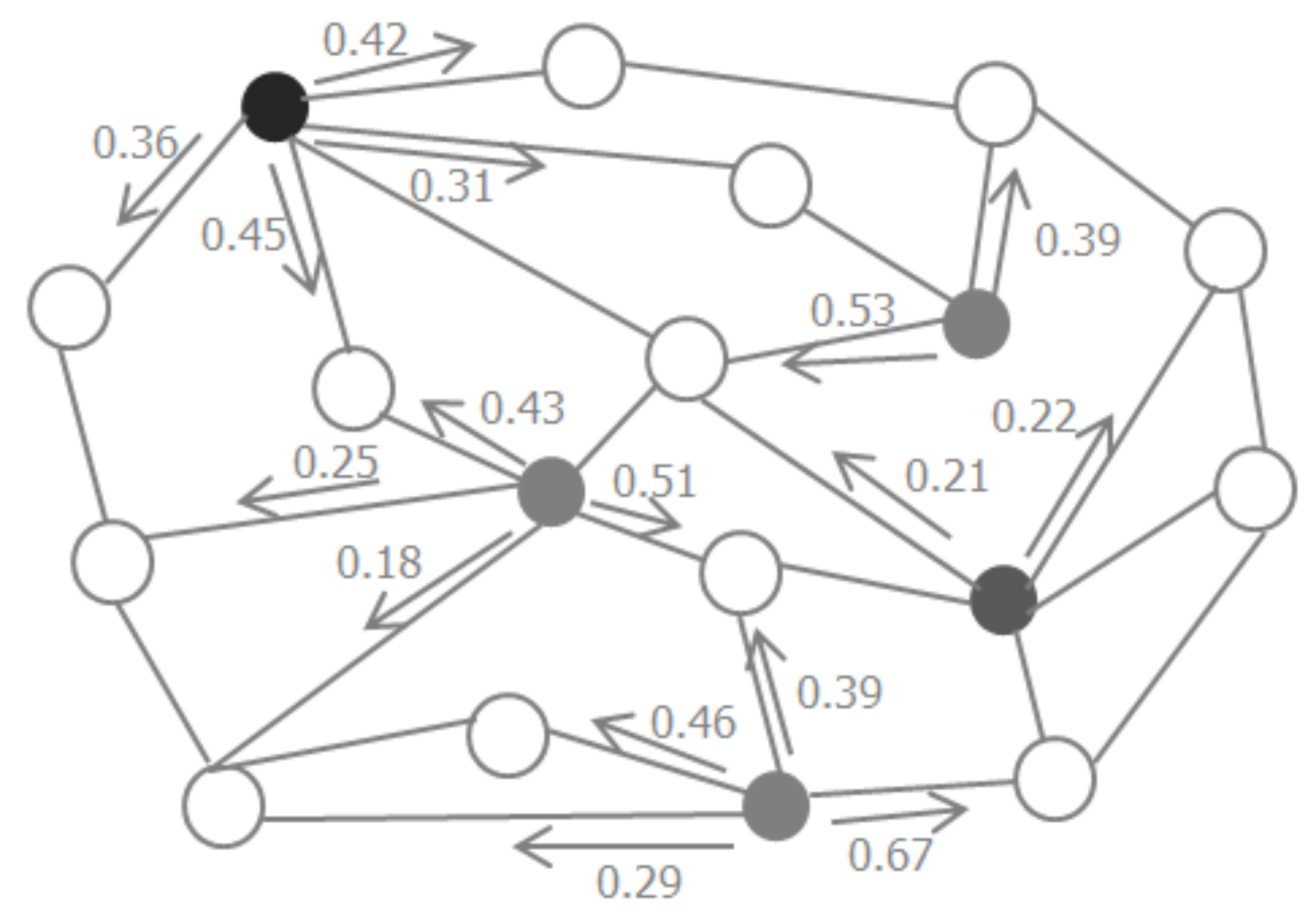
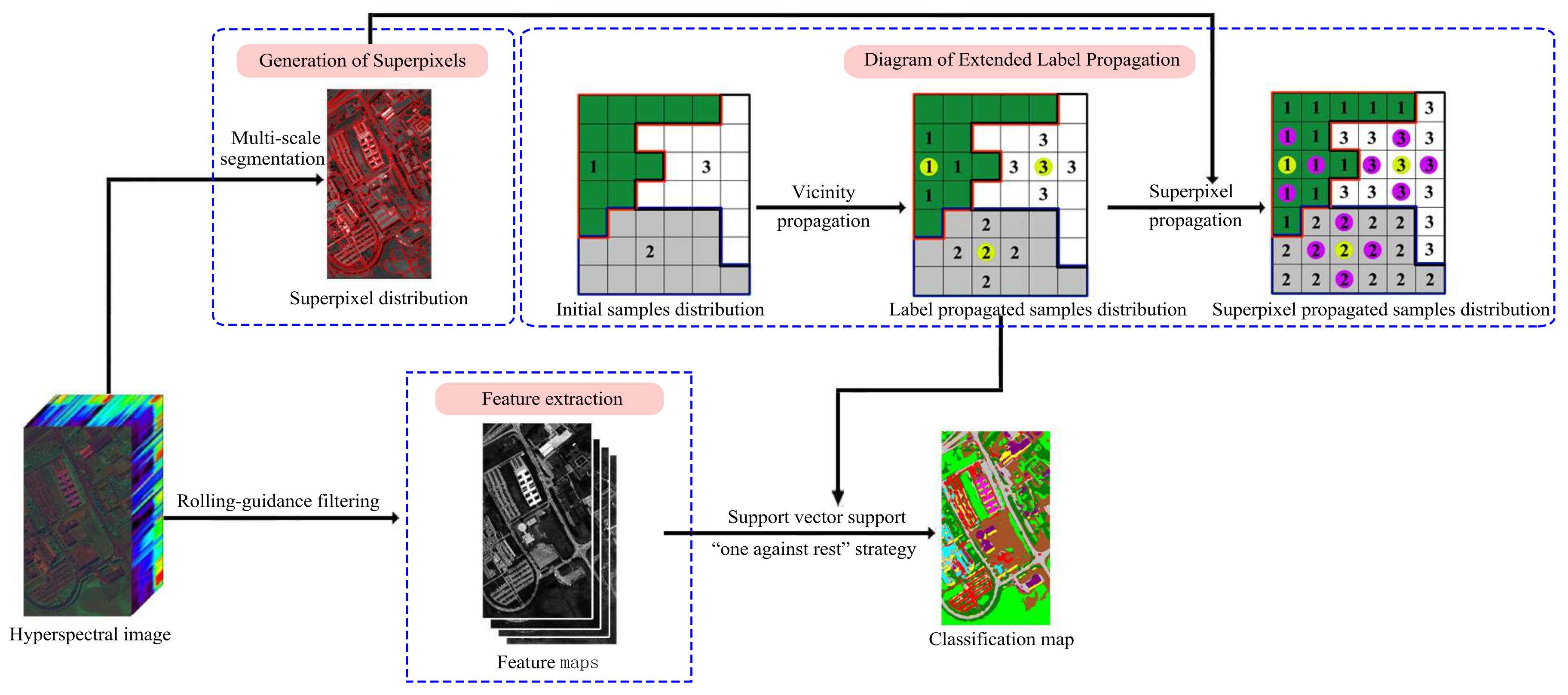

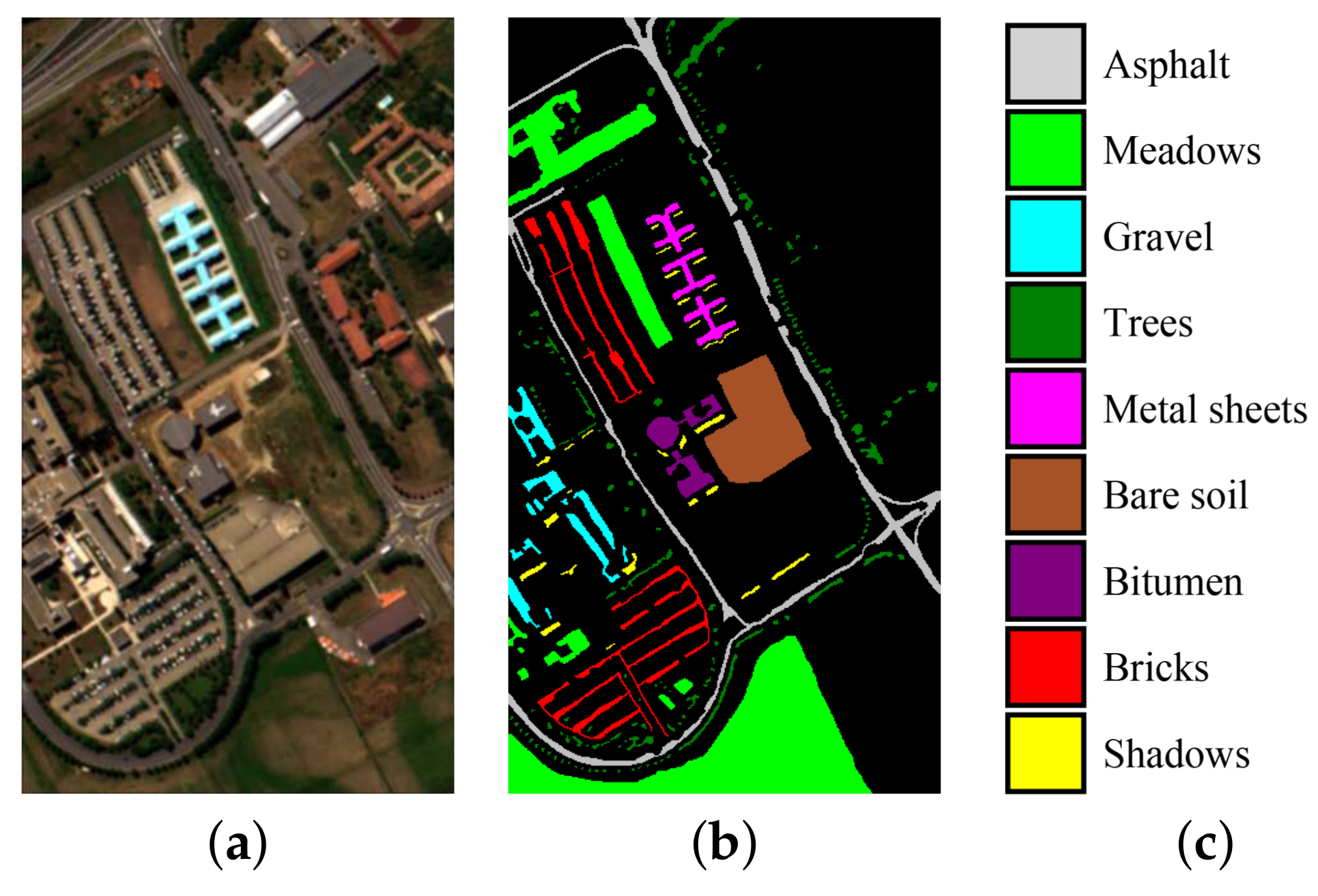
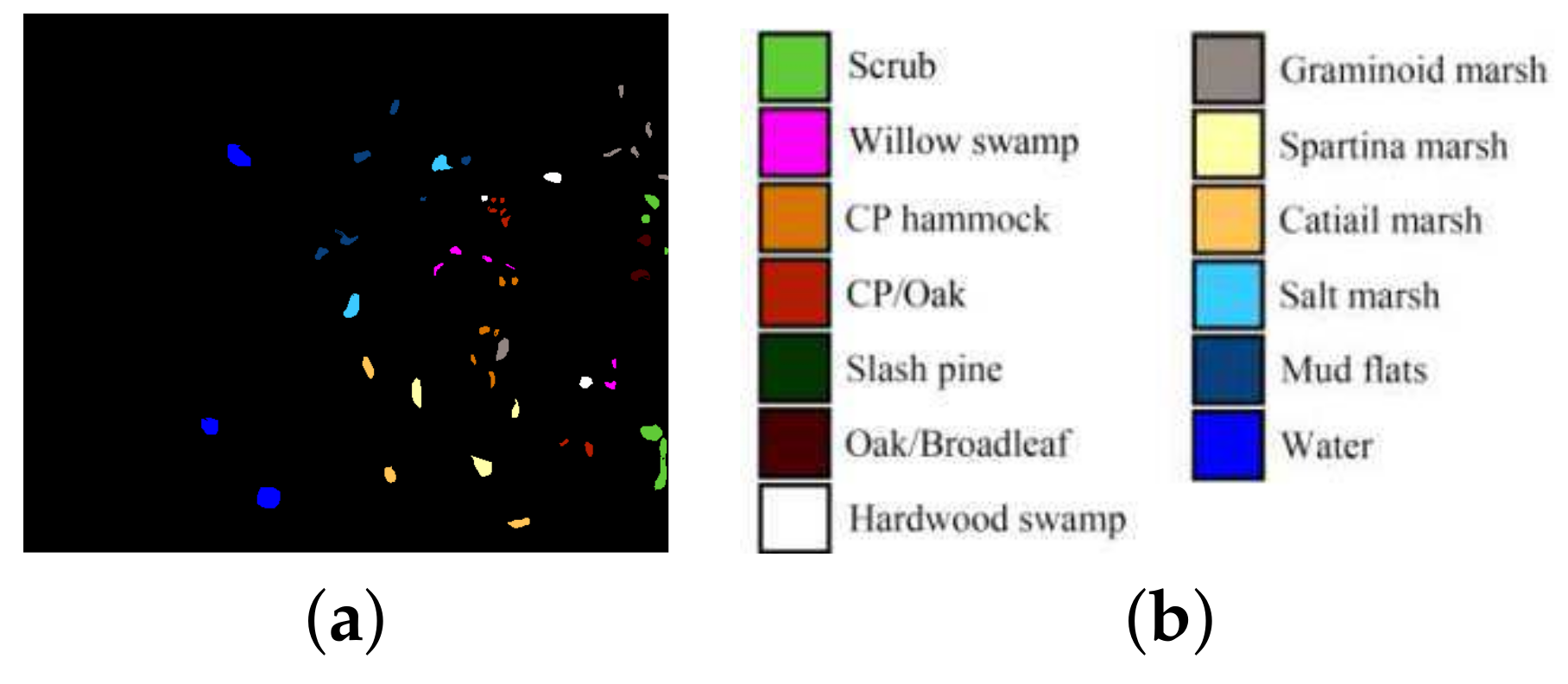


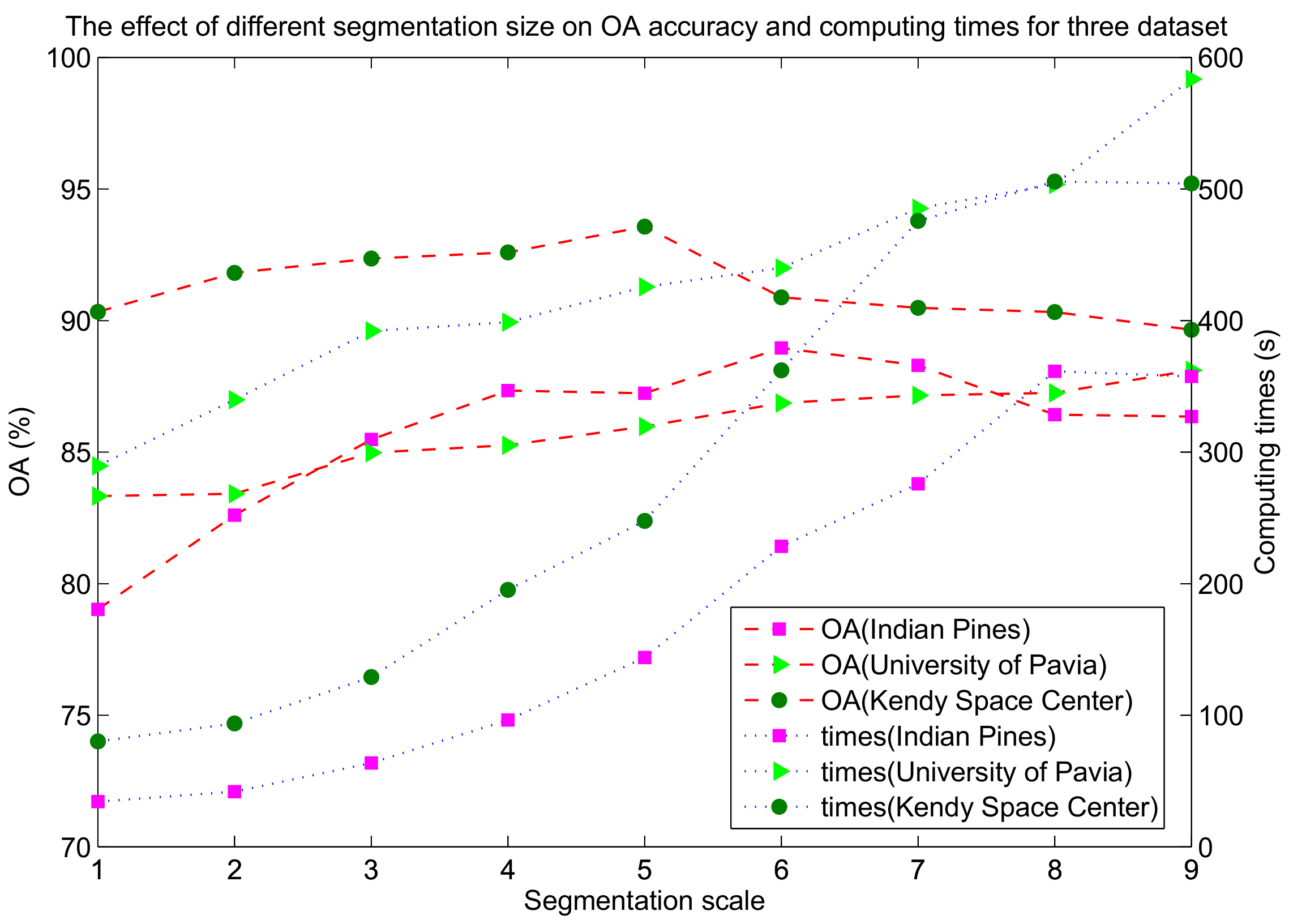
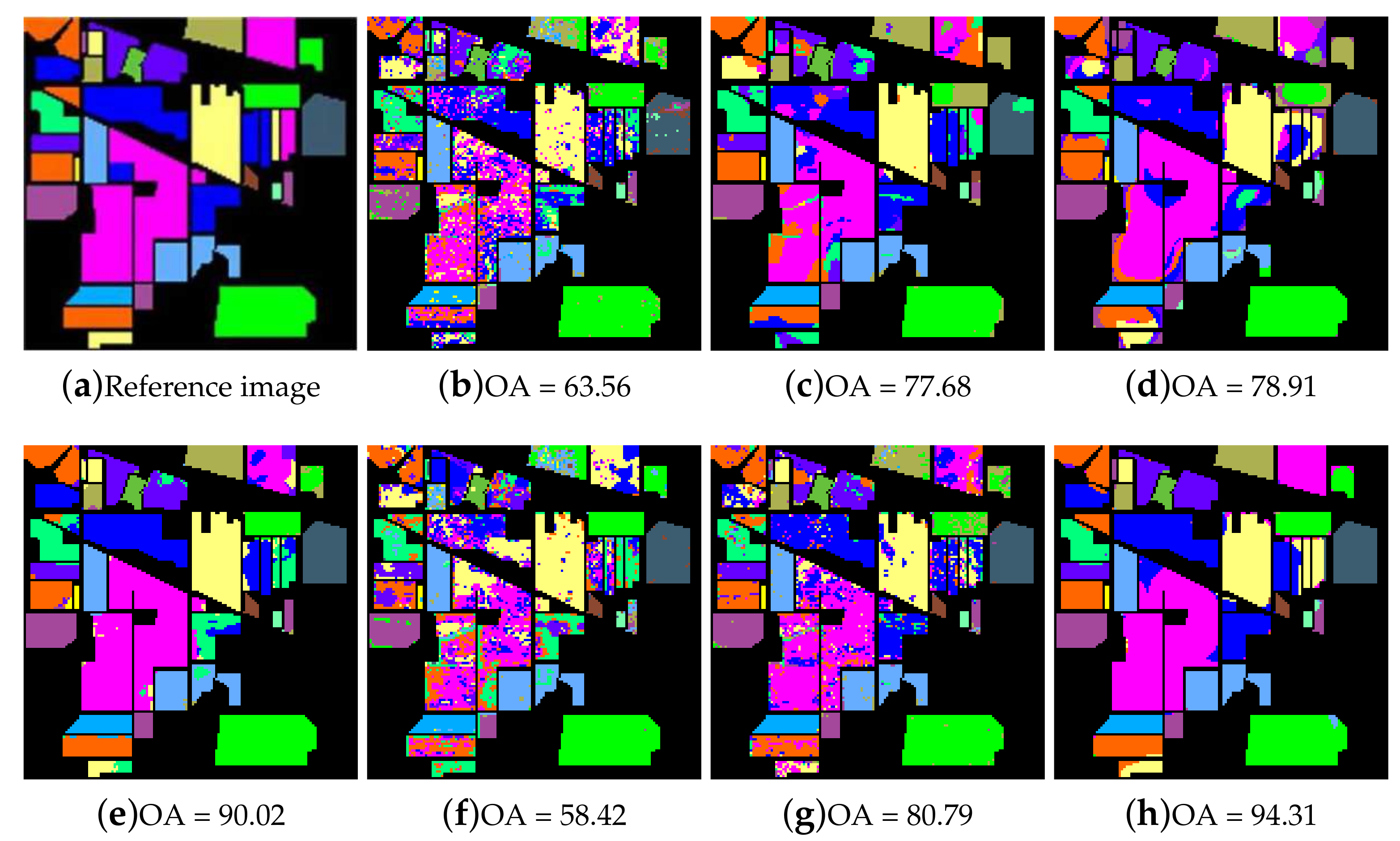


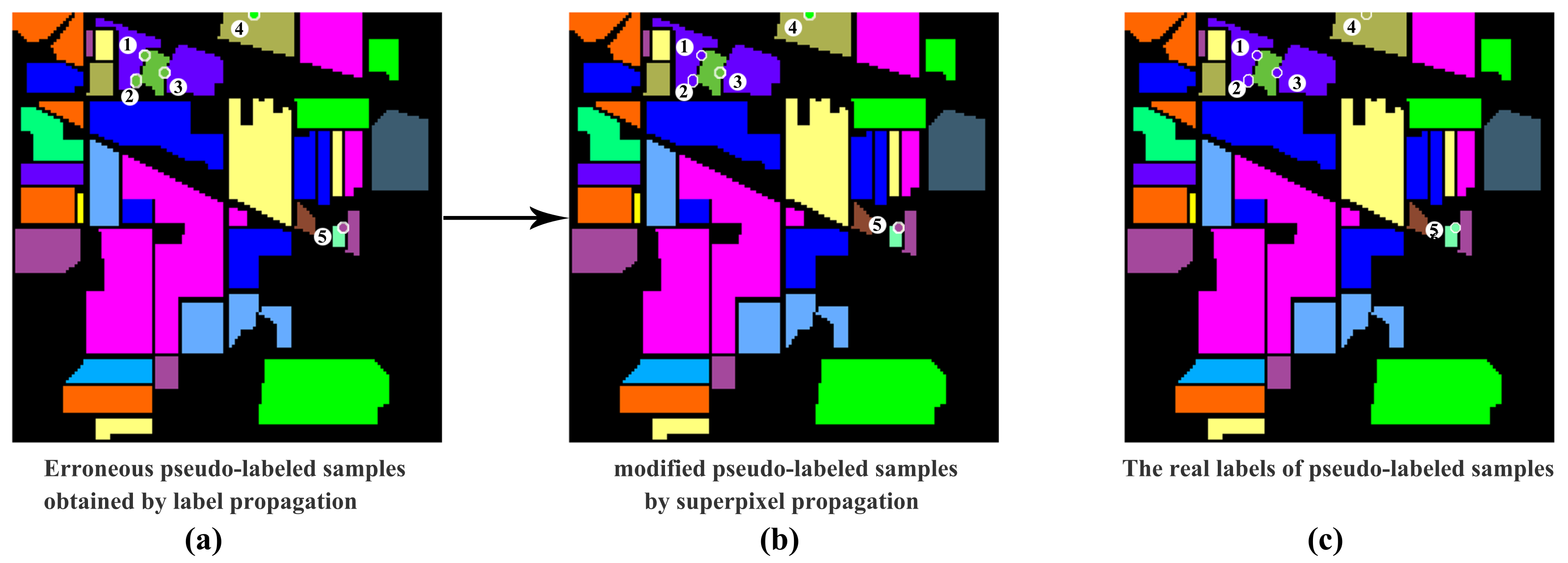
| Methods | Metrics | Training Samples per Class (s) | ||
|---|---|---|---|---|
| s = 5 | s = 10 | s = 15 | ||
| SVM | OA | 45.31 ± 5.19 | 57.58 ± 2.98 | 63.56 ± 2.61 |
| AA | 47.41 ± 3.71 | 55.19 ± 2.27 | 59.84 ± 2.21 | |
| Kappa | 39.21 ± 5.43 | 52.52 ± 3.17 | 59.11 ± 2.82 | |
| EPF | OA | 57.97 ± 5.93 | 69.89 ± 3.45 | 77.68 ± 3.08 |
| AA | 61.35 ± 6.40 | 70.07 ± 3.47 | 79.58 ± 2.70 | |
| Kappa | 52.91 ± 6.50 | 66.12 ± 3.77 | 74.80 ± 3.45 | |
| RGF | OA | 56.14 ± 5.33 | 70.49 ± 4.69 | 78.91 ± 1.39 |
| AA | 61.18 ± 4.89 | 68.49 ± 5.03 | 74.52 ± 2.77 | |
| Kappa | 51.13 ± 5.82 | 66.89 ± 5.08 | 76.14 ± 1.55 | |
| ERW | OA | 72.30 ± 4.38 | 84.87 ± 4.41 | 90.02 ± 1.30 |
| AA | 83.32 ± 2.41 | 91.48 ± 2.30 | 94.39 ± 0.94 | |
| Kappa | 68.96 ± 4.69 | 82.95 ± 4.86 | 88.69 ± 1.46 | |
| LapSVM | OA | 42.50 ± 0.27 | 58.58 ± 0.46 | 58.42 ± 0.32 |
| AA | 50.96 ± 1.36 | 61.54 ± 0.26 | 62.20 ± 0.86 | |
| Kappa | 36.89 ± 0.54 | 53.01 ± 0.32 | 53.82 ± 0.36 | |
| SSLP-SVM | OA | 64.84 ± 1.43 | 76.05 ± 0.73 | 80.79 ± 1.44 |
| AA | 65.96 ± 2.38 | 78.07 ± 0.64 | 82.08 ± 0.98 | |
| Kappa | 60.63 ± 1.49 | 73.17 ± 0.80 | 78.38 ± 1.60 | |
| ELP-RGF | OA | 79.13 ± 1.80 | 89.14 ± 1.06 | 94.31 ± 0.75 |
| AA | 77.65 ± 2.94 | 88.98 ± 1.37 | 94.45 ± 1.54 | |
| Kappa | 76.37 ± 2.03 | 87.68 ± 1.20 | 93.53 ± 0.85 | |
| Method | s = 5 | s = 10 | s = 15 |
|---|---|---|---|
| SVM | 61.54 ± 5.15 | 67.70 ± 4.72 | 69.62 ± 3.35 |
| EPF | 58.98 ± 8.58 | 71.07 ± 8.02 | 80.86 ± 6.37 |
| RGF | 55.85 ± 7.22 | 74.82 ± 4.49 | 83.02 ± 4.87 |
| ERW | 80.70 ± 6.45 | 90.28 ± 3.71 | 92.57 ± 4.36 |
| LapSVM | 62.23 ± 2.03 | 63.03 ± 0.22 | 67.65 ± 0.43 |
| SSLP-SVM | 67.15 ± 2.45 | 82.15 ± 0.71 | 83.49 ± 1.30 |
| ELP-RGF | 82.39 ± 1.42 | 91.54 ± 1.54 | 93.73 ± 1.37 |
| Class | Training | Test | Accuracy of Classification | ||||||
|---|---|---|---|---|---|---|---|---|---|
| SVM | EPF | RGF | ERW | LapSVM | SSLP-SVM | ELP-RGF | |||
| Scrub | 3 | 758 | 92.25 ± 6.15 | 90.55 ± 2.25 | 96.78 ± 6.92 | 88.68 ± 17.99 | 87.17 ± 6.13 | 87.19 ± 6.27 | 100 |
| Willow swamp | 3 | 240 | 72.87 ± 9.38 | 86.74 ± 1.47 | 81.32 ± 14.78 | 68.56 ± 20.13 | 95.63 ± 0.69 | 77.38 ± 4.59 | 99.75 ± 0.30 |
| CP hammock | 3 | 253 | 70.65 ± 9.02 | 87.00 ± 2.36 | 75.16 ± 19.67 | 62.70 ± 23.84 | 70.90 ± 2.85 | 85.87 ± 6.56 | 93.06 ± 5.65 |
| CP/Oak | 3 | 249 | 35.41 ± 9.23 | 54.50 ± 2.26 | 37.26 ± 18.71 | 77.10 ± 22.45 | 83.97 ± 10.32 | 51.97 ± 16.92 | 75.49 ± 22.72 |
| Slash pine | 3 | 158 | 43.04 ± 10.74 | 59.64 ± 3.01 | 46.26 ± 39.56 | 88.29 ± 8.81 | 79.08 ± 1.60 | 41.13 ± 8.29 | 55.95 ± 4.09 |
| Oak/Broadleaf | 3 | 226 | 38.53 ± 18.23 | 62.16 ± 3.04 | 58.85 ± 43.78 | 94.48 ± 15.44 | 89.62 ± 3.27 | 36.43 ± 9.46 | 95.64 ± 3.89 |
| Hardwood swamp | 3 | 102 | 52.88 ± 17.18 | 77.62 ± 1.65 | 80.03 ± 20.80 | 100 | 96.34 ± 1.18 | 72.06 ± 10.95 | 98.79 ± 1.15 |
| Graminoid marsh | 3 | 428 | 43.90 ± 16.09 | 66.50 ± 2.03 | 67.77 ± 37.25 | 76.09 ± 21.61 | 93.34 ± 1.26 | 76.47 ± 11.11 | 99.10 ± 0.74 |
| Spartina marsh | 3 | 517 | 75.42 ± 10.30 | 81.25 ± 2.12 | 85.19 ± 12.89 | 78.86 ± 19.25 | 98.12 ± 0.67 | 89.52 ± 3.21 | 97.21 ± 3.90 |
| Cattail marsh | 3 | 401 | 59.72 ± 28.96 | 72.09 ± 2.73 | 61.39 ± 43.02 | 72.13 ± 23.05 | 92.90 ± 9.77 | 75.53 ± 13.87 | 84.79 ± 17.69 |
| Salt marsh | 3 | 416 | 89.04 ± 23.01 | 90.09 ± 2.42 | 89.94 ± 24.64 | 85.56 ± 22.82 | 94.92 ± 4.07 | 84.47 ± 16.34 | 99.95 ± 0.10 |
| Mud flats | 3 | 500 | 67.62 ± 16.57 | 78.70 ± 2.39 | 89.86 ± 14.49 | 73.77 ± 26.25 | 94.22 ± 2.25 | 68.16 ± 7.82 | 94.21 ± 4.38 |
| Water | 3 | 924 | 98.58 ± 2.35 | 98.90 ± 0.59 | 83.33 ± 40.82 | 93.36 ± 16.74 | 99.08 ± 0.72 | 99.15 ± 0.78 | 100 |
| OA | 65.45 ± 8.12 | 76.13 ± 0.96 | 66.81 ± 7.87 | 82.21 ± 4.36 | 91.25 ± 1.18 | 75.52 ± 1.24 | 93.21 ± 2.44 | ||
| AA | 64.61 ± 4.10 | 77.36 ± 0.68 | 73.32 ± 4.56 | 81.51 ± 3.59 | 90.41 ± 0.81 | 72.72 ± 1.18 | 91.84 ± 2.23 | ||
| Kappa | 61.76 ± 8.76 | 73.52 ± 1.02 | 63.52 ± 8.44 | 80.25 ± 4.79 | 90.25 ± 1.32 | 72.88 ± 1.35 | 92.45 ± 2.71 | ||
| Method | s = 5 | s = 10 | s = 15 |
|---|---|---|---|
| SVM | 74.05 ± 3.65 | 83.12 ± 1.83 | 85.96 ± 1.31 |
| EPF | 85.48 ± 4.26 | 92.66 ± 2.82 | 96.24 ± 1.87 |
| RGF | 87.05 ± 4.32 | 95.30 ± 1.76 | 97.42 ± 1.51 |
| ERW | 88.29 ± 3.19 | 96.85 ± 1.37 | 97.93 ± 0.94 |
| LapSVM | 61.40 ± 0.12 | 71.94 ± 0.10 | 74.09 ± 0.30 |
| SSLP-SVM | 82.01 ± 2.93 | 90.61 ± 0.90 | 93.15 ± 0.53 |
| ELP-RGF | 94.12 ± 0.65 | 99.05 ± 0.24 | 99.38 ± 0.12 |
| Methods | Data Set | Initial Samples | Increased Samples | Incorrect Labeled Samples | Correct Rate |
|---|---|---|---|---|---|
| SSLP-SVM | Indian Pines | 108 | 349 | 1 | 99.71% |
| University of Pavia | 90 | 1028 | 4 | 99.61% | |
| Kennedy Space Center | 39 | 115 | 0 | 100% | |
| ELP-RGF | Indian Pines | 108 | 2998 | 25 | 99.17% |
| University of Pavia | 90 | 7440 | 9 | 99.88% | |
| Kennedy Space Center | 39 | 2558 | 25 | 99.02% |
| Data Set | RGF | LP-RGF | SP-RGF | ELP-RGF |
|---|---|---|---|---|
| Indian Pines | 56.14 | 67.63 | 75.62 | 79.13 |
| University of Pavia | 55.85 | 75.22 | 74.25 | 82.39 |
| Kennedy Space Center | 87.05 | 89.33 | 93.97 | 94.12 |
© 2018 by the authors. Licensee MDPI, Basel, Switzerland. This article is an open access article distributed under the terms and conditions of the Creative Commons Attribution (CC BY) license (http://creativecommons.org/licenses/by/4.0/).
Share and Cite
Cui, B.; Xie, X.; Hao, S.; Cui, J.; Lu, Y. Semi-Supervised Classification of Hyperspectral Images Based on Extended Label Propagation and Rolling Guidance Filtering. Remote Sens. 2018, 10, 515. https://doi.org/10.3390/rs10040515
Cui B, Xie X, Hao S, Cui J, Lu Y. Semi-Supervised Classification of Hyperspectral Images Based on Extended Label Propagation and Rolling Guidance Filtering. Remote Sensing. 2018; 10(4):515. https://doi.org/10.3390/rs10040515
Chicago/Turabian StyleCui, Binge, Xiaoyun Xie, Siyuan Hao, Jiandi Cui, and Yan Lu. 2018. "Semi-Supervised Classification of Hyperspectral Images Based on Extended Label Propagation and Rolling Guidance Filtering" Remote Sensing 10, no. 4: 515. https://doi.org/10.3390/rs10040515
APA StyleCui, B., Xie, X., Hao, S., Cui, J., & Lu, Y. (2018). Semi-Supervised Classification of Hyperspectral Images Based on Extended Label Propagation and Rolling Guidance Filtering. Remote Sensing, 10(4), 515. https://doi.org/10.3390/rs10040515





